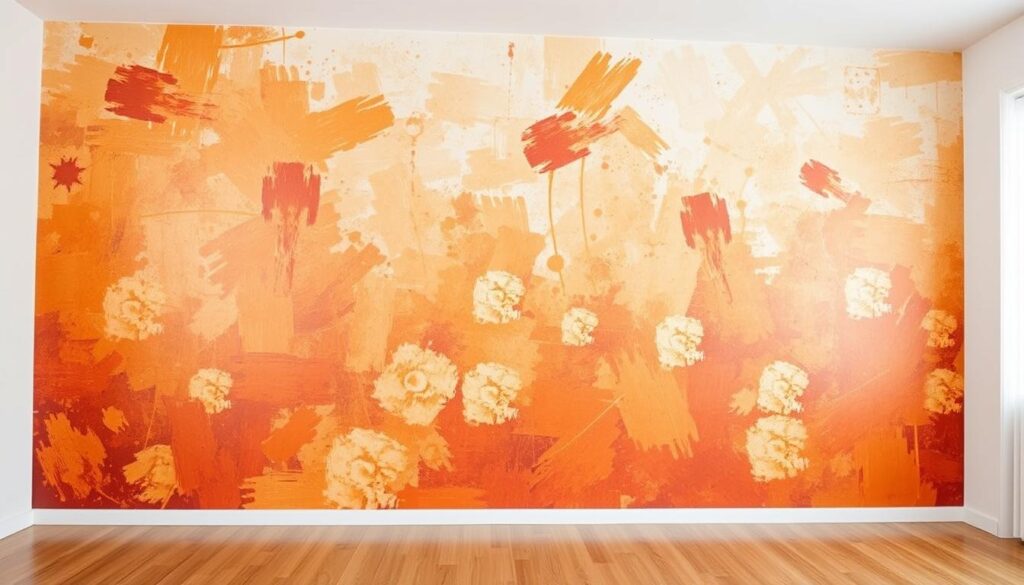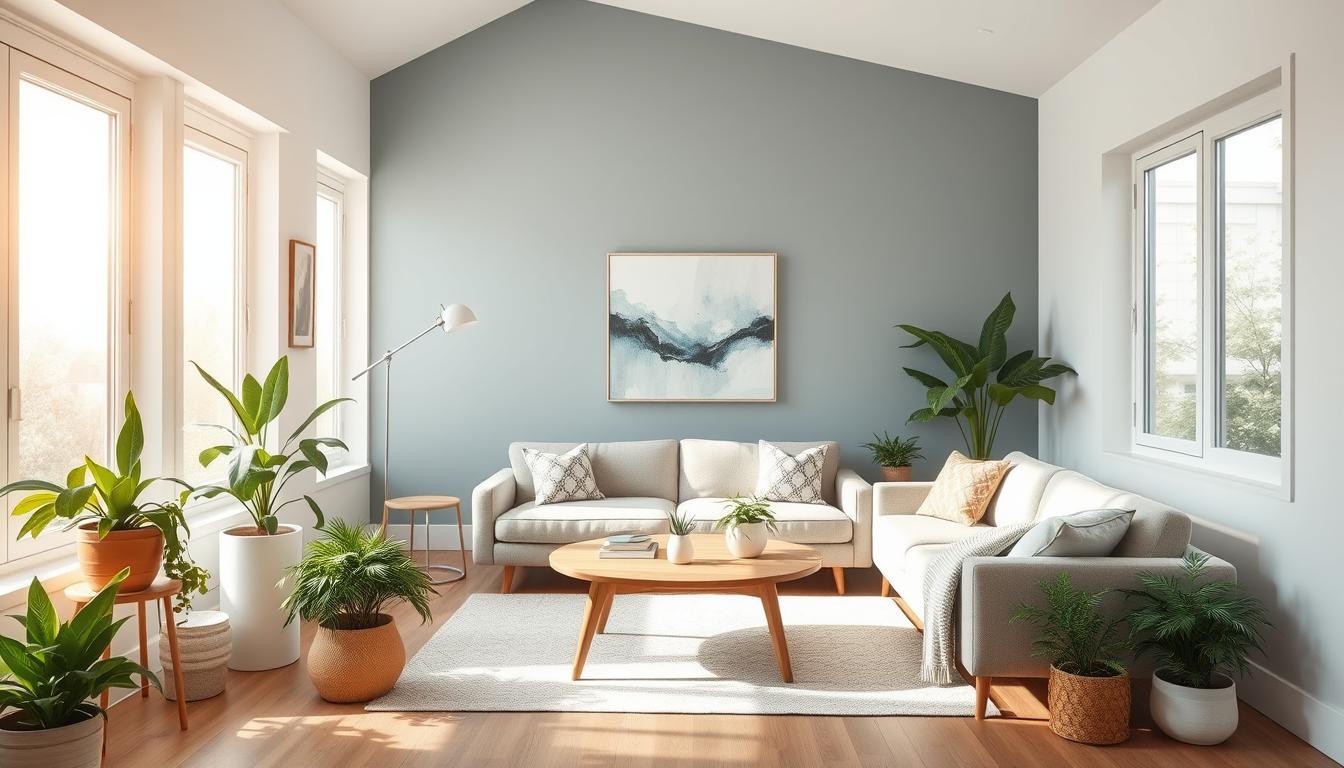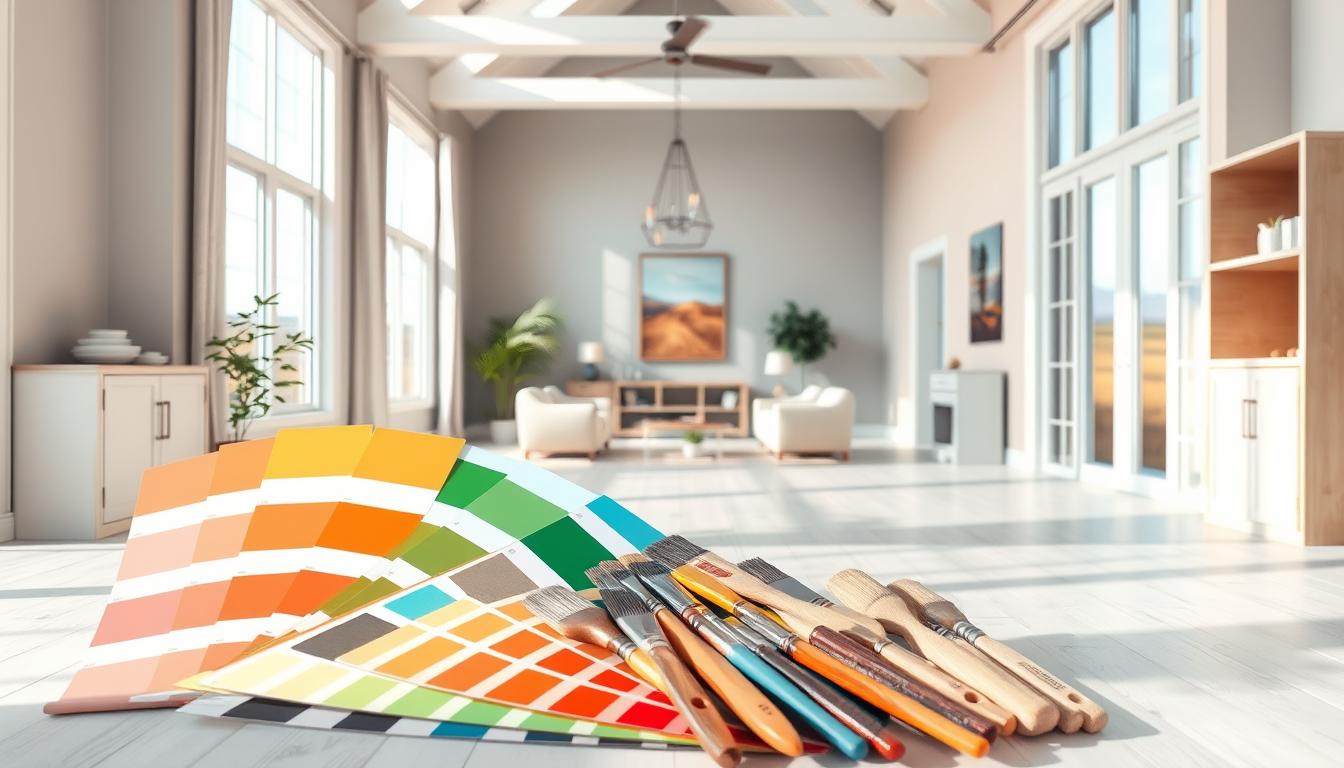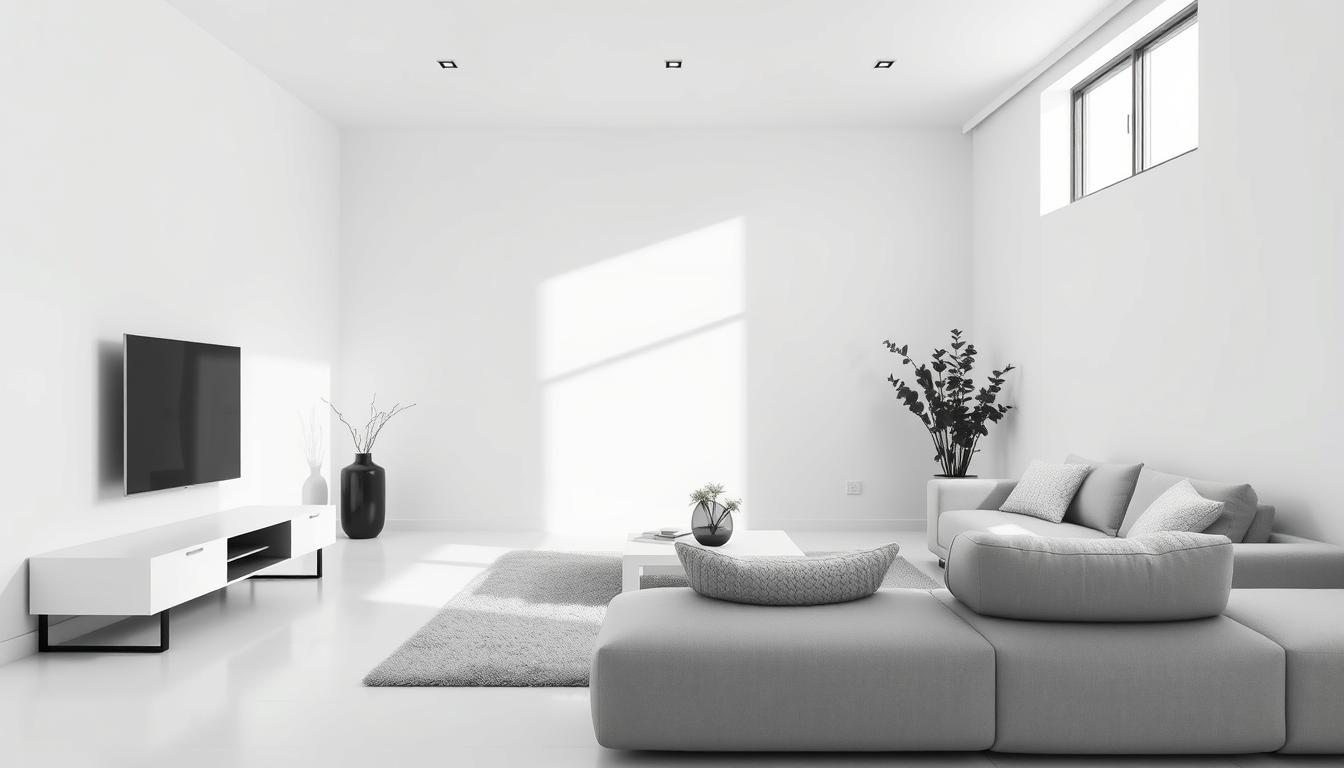Refreshing your living space can be as easy as picking the right paint colors. Did you know a new paint job can boost your property’s value by up to 5%? This makes it a smart choice for homeowners wanting to improve their home.
We think a well-designed space can really change how you feel and work. With our best paint ideas, you can make a space that shows off your personality and style.
Key Takeaways
- Discover the latest trends in interior design inspiration
- Learn how to choose the perfect paint colors for your space
- Get expert tips on how to increase your property’s value with a fresh coat of paint
- Explore our top paint ideas for a stylish refresh
- Find out how to create a space that reflects your personality and style
Understanding the Importance of Interior Paint
Interior paint does more than just cover walls. It affects our mood and how we see things. Refreshing our home starts with paint. It’s a simple way to change how our spaces feel and look.
The Psychological Impact of Color
Colors deeply influence our feelings and actions. Cool colors like blues and greens calm us, great for bedrooms and bathrooms. Warm colors such as oranges and reds boost energy, perfect for living rooms and dining areas.
Choosing paint color wisely is key. It’s not just about what we like. It’s about creating a mood that makes the room work better.
Choosing the Right Finish
The paint finish matters as much as the color. Different finishes change a room’s look. For example, a matte finish hides wall flaws, while a glossy finish brightens colors and is easy to clean.
- Matte finish: Ideal for low-traffic areas and ceilings.
- Eggshell finish: Suitable for living rooms and bedrooms.
- Satin finish: Great for kitchens and bathrooms due to its durability.
- Glossy finish: Best for trim and doors.
How Paint Affects Space Perception
Paint also changes how we see room size. Light colors make rooms seem bigger by reflecting light. Dark colors create a cozy feel, making big rooms feel more intimate.
By picking the right color and finish, we can change how we see space. This is a key part of interior design.
Popular Color Trends for Home Interiors
The world of interior design is always changing. One key way to update your home is by using the latest paint colors. You’ll learn how to make your home look fresh and modern with the most popular color schemes.
Earthy Tones and Natural Hues
Earthy tones and natural hues are still popular in home design. They remind us of nature and add warmth and coziness. Try using shades like sage green, sandy beige, or driftwood gray in your color schemes for a calming feel.
Bold and Vibrant Accents
For a bold statement, use vibrant accents in your space. Colors like deep blues, rich reds, and sunny yellows can be eye-catching. Just remember to balance these bold colors with neutral shades to keep the room feeling balanced.
Subtle Neutrals for Timeless Elegance
Neutral colors are always in style and work well with any decor. Soft whites, creamy ivories, and gentle grays can make a room feel bigger and more peaceful. These popular paint colors are great for a timeless, elegant look that won’t follow any trend.
Using these popular color trends can give your home a stylish update that shows off your taste. Whether you like the warmth of earthy tones, the boldness of vibrant colors, or the elegance of neutrals, there’s a color scheme for you.
Room-by-Room Paint Ideas
Let’s dive into picking the perfect paint for each room. This will make your home feel welcoming and inviting. Different rooms have different uses, and the right paint can make each space better.
Living Room: Creating Inviting Spaces
The living room is the heart of the home, where everyone gathers. Choose warm, inviting colors for this space. Earth tones like beige, taupe, or soft gray are great. For something bolder, rich blue or green adds depth and class.
For your living room, a satin or eggshell finish is best. It has a subtle sheen and is easy to clean.
Bedroom: Relaxing Color Palettes
Bedrooms are for rest and relaxation. Soft colors like light blues, pale greens, or gentle lavenders create a calm vibe. Warmer neutrals like caramel or soft peach can make it cozier.
“The color of the walls can significantly impact the ambiance of a bedroom. Soft colors can make a room feel more spacious and relaxing.”
In bedrooms, a flat or matte finish works well. It reduces glare and looks smooth and calming.
Kitchen and Dining: Energizing Choices
Kitchens and dining areas are for meals and fun. Bright, cheerful colors can boost appetite and conversation. Try vibrant hues like sunny yellow, bright red, or orange for energy. Soft whites, creams, or light grays offer a clean, inviting look.
| Room | Recommended Colors | Finish |
|---|---|---|
| Living Room | Earth tones, rich blues, greens | Satin, Eggshell |
| Bedroom | Soft blues, pale greens, lavenders | Flat, Matte |
| Kitchen & Dining | Vibrant hues, soft whites, creams | High-gloss, Semi-gloss |
Choosing the right paint for each room can make your home look and feel better. It makes your home a more enjoyable place to be.
Accent Walls: Making a Statement
An accent wall is more than a bold paint choice. It’s a design statement that can change a room’s feel. By focusing on one wall, you add depth, create a focal point, and bring personality to your space.
Selecting the Right Wall
Choosing the right wall for your accent wall is key. Think about the room’s layout and how people move through it. A wall that naturally catches the eye, like the one behind a fireplace, is often the best choice.
- Look for a wall that is visible when you enter the room.
- Avoid walls with too many windows or doors.
- Consider the wall’s architectural features, such as built-in shelves or alcoves.
Complementary Colors and Patterns
The color and pattern of your accent wall should match your decor. Creative wall painting techniques like ombre, stripes, or geometric patterns add interest.
When picking a color, think about the mood you want:
- Soft blues or greens for a calming feel.
- Vibrant colors like red or orange for a bold statement.
- Deep, rich tones like charcoal or navy blue for a sophisticated look.

Tips for Application and Design
Painting your accent wall needs some painting tips for a pro finish. First, make sure the wall is clean and dry. Use painter’s tape for sharp edges, and prime if needed.
For a unique look, try layering colors or stencils. The goal is balance; your bold wall should enhance, not overwhelm, the space.
By following these tips and being creative, you can make an accent wall that stands out. It will not only make a statement but also improve your room’s look.
Seasonal Paint Ideas for a Fresh Look
Every season brings a chance to refresh your home with new paint. As seasons change, our homes can feel old if not updated. Painting is a simple way to make your home look modern and welcoming.
Springtime Pastels
Spring is the perfect time for soft, pastel colors in your home. Think pale pink, baby blue, and mint green. These colors create a calm and fresh atmosphere.
“Pastel colors are not just for Easter; they’re a great way to bring a soft, whimsical feel to your home in the spring.” You can use pastel colors on walls, ceilings, or furniture.
Summer Brights and Cheery Colors
Summer is the time for bright colors. Try sunny yellow, sky blue, and coral red. These colors add energy and warmth to your home.
As Benjamin Moore says, “A fresh coat of paint in a bright summer color can completely transform a room.” Use these colors on accent walls or trim for a pop of color.
Autumn Warmth and Rich Tones
Autumn brings warm, rich tones to your home. Think burnt orange, deep red, and golden brown. These colors make your home feel cozy and inviting.
According to
“The right autumnal color palette can make your home feel like a warm hug on a chilly fall day.”
Using these warm tones is a great way to change your home’s look from summer to fall.
By using these seasonal paint ideas, you can keep your home looking fresh all year. Whether you paint one room or the whole house, the right colors make a big difference.
Techniques for Adding Texture with Paint
Paint can add depth and interest to your walls. Texture is key in interior design, making rooms feel lively. By using different textures, you can make your space unique and personal.

Textured Roller and Sponges
Using a textured roller or sponges is simple and effective. These tools can make various patterns, from subtle to bold. A textured roller gives a uniform look, while sponges create organic textures.
For the best results with a textured roller, pick the right nap length. With sponging, try different sponge sizes and densities for varied textures.
DIY Techniques for Unique Effects
For creative projects, try DIY techniques for unique wall effects. Ragging uses a rag to remove paint, creating a soft look. Faux finishing mimics materials like marble or wood with paint and glaze.
These methods need practice but can add depth to your walls. Mixing techniques can lead to a unique finish.
Using Stencils for Custom Designs
Stencils are great for adding patterns and texture. They range from simple shapes to detailed floral designs. Stencils can highlight a room or add interest to a plain wall.
Choose a stencil that fits your room’s style. Use one color or multiple for depth. For a subtle look, try glaze or textured paint with your stencil.
| Technique | Description | Best For |
|---|---|---|
| Textured Roller | Creates uniform patterns | Large areas, uniform look |
| Sponging | Adds organic, irregular textures | Accent walls, unique effects |
| Ragging | Creates soft, mottled effects | Subtle texture, layered look |
| Faux Finishing | Mimics other materials like marble or wood | High-end, sophisticated look |
| Stenciling | Adds custom designs and patterns | Focal points, decorative accents |
Sustainable Paint Options
The move towards eco-friendly home decor is more than a trend; it’s essential. This starts with choosing sustainable paint options. As people become more eco-aware, the need for green paint brands has grown a lot.
Eco-Friendly Paint Brands to Consider
Many paint brands have stepped up, offering products that look great and are good for the planet. Some top eco-friendly paint brands include:
- Benjamin Moore’s Natura: Known for its zero-VOC paint line.
- Behr’s Premium Plus ULTRA: Offers low-VOC options.
- Sherwin-Williams’ ProMar 200: Provides low-VOC paints.
These brands are making big moves to lessen the environmental harm of painting projects.
Benefits of Low-VOC and Zero-VOC Paints
Low-VOC and zero-VOC paints help cut down on indoor air pollution. The advantages are:
| Feature | Low-VOC Paints | Zero-VOC Paints |
|---|---|---|
| Indoor Air Quality | Improved | Significantly Improved |
| Environmental Impact | Reduced | Minimal |
| Health Risks | Lowered | Minimal to None |
Deciding between low-VOC and zero-VOC paints depends on your needs and how green you want to be.
How to Recycle Old Paint Properly
Recycling old paint is key to cutting down on waste. Here’s how to do it:
- Look up local paint recycling programs.
- Many hardware stores have paint recycling services.
- Dispose of paint cans responsibly, making sure they’re empty and dry.
By following these steps, we can greatly reduce the environmental impact of our painting projects.
Preparing Your Space for Painting
A successful painting project starts with good preparation. This makes the painting process smooth and efficient. It also leads to a professional-looking finish.
Clearing Furniture and Prep Work
Before painting, clear the room of furniture. Cover the floor and any items left with drop cloths or plastic sheets. This protects your belongings from paint spills and splatters.
- Remove furniture, curtains, and rugs from the room.
- Cover the floor, furniture that can’t be removed, and fixtures with protective coverings.
- Clean the walls to remove dirt, grime, or grease that might affect paint adhesion.
Choosing the Right Tools
Choosing the right tools is key for a successful painting project. You’ll need the right paintbrushes, rollers, and other equipment.
| Tool | Description | Use Case |
|---|---|---|
| Paintbrushes | Available in various sizes and bristle types | For cutting in, edges, and corners |
| Rollers | Different nap lengths for smooth or textured surfaces | For covering large areas quickly |
| Paint Tray | For holding and carrying paint | Essential for painting with rollers |
Safety Precautions
Safety is the most important thing when painting. Always wear protective gear and make sure the area is well-ventilated.
“Safety is not just a precaution, it’s a necessity when working with potentially hazardous materials like paint.”
- Wear protective gloves, goggles, and a mask.
- Ensure the area is well-ventilated to prevent inhaling fumes.
- Follow the manufacturer’s instructions for paint and other products.
DIY vs. Hiring a Professional
Choosing between DIY painting and hiring a pro is a big decision for your home. Both paths have their good and bad sides. We’ll look at these to guide you in your choice.
Pros and Cons of DIY Painting
DIY painting can save money and let you control the work. But, it takes a lot of time and effort. You’ll need to buy good paint and tools and might make mistakes.
- Pros:
- Cost savings on labor
- Control over the painting process
- Flexibility to work at your own pace
- Cons:
- Time-consuming
- Potential for errors
- Physical demands of the job
Benjamin Moore, a top paint maker, says, “The right paint can make all the difference, but so can the application.” This shows choosing the right paint is key, but applying it well is just as important.
When to Call in Professionals
There are times when hiring a pro is best. If you’re busy, new to painting, or have a big project, pros can do a great job.
“Hiring a professional painter can be a worthwhile investment, for bigger or more complex projects. They have the skills, work fast, and guarantee quality.” –
| Factor | DIY | Professional |
|---|---|---|
| Cost | Lower upfront cost | Higher upfront cost |
| Time | Significant time investment | Saves time |
| Quality | Variable quality | High-quality finish |
Budgeting for Your Painting Project
Whether DIY or hiring a pro, budgeting is key. For DIY, think about paint, tools, and equipment costs. For pros, get quotes and ask about extra fees.
By thinking about your options and planning your budget, you can get the home makeover you want without spending too much.
Incorporating Patterns into Your Interior Design
Patterns are a great way to make your space stylish and welcoming. They add depth, texture, and interest. Using patterns well can make your room look cohesive and show off your style.
Stripes and Geometric Patterns
Stripes and geometric patterns are great for adding interest. Stripes can make a room feel taller or wider. Geometric patterns bring a modern vibe. Think about the scale and colors you use. Bold stripes can make a big statement, while subtle geometric patterns add sophistication.
When using stripes, balance them with solid colors. The 60-30-10 rule is helpful: 60% of the room is a main color, 30% a secondary, and 10% an accent. This balance makes the space look good.
Floral and Organic Design Choices
Floral and organic patterns add warmth and coziness. Use them on wallpaper, upholstery, or rugs for a unified look. Mix floral patterns with solid colors or other subtle patterns to avoid too much. For example, a floral sofa with a solid wall and a geometric rug works well.
“The key to mixing patterns is to find a common thread, such as a shared color or texture, that ties the different patterns together.”
Mixing Patterns: Best Practices
Mixing patterns can be tricky, but with some tips, you can get it right. Choose a main pattern and add secondary ones that match it. Think about the scale, color, and texture of each pattern.
- Start with a neutral base: Use a neutral color on walls and large furniture pieces to provide a calm background for patterned accents.
- Vary the scale: Mixing patterns of different scales can add visual interest and depth to a room.
- Unify with color: Choose patterns that share a common color to create a cohesive look.
By using patterns in your design and following these tips, you can make a stylish and inviting space. Whether you like bold or subtle patterns, the most important thing is to have fun and find what works for you.
Final Touches: Accessories and Furniture
Now that your walls are painted, it’s time to add the finishing touches. We’ll look at how to pick accessories and furniture that make your space inviting and harmonious.
Fabric and Textile Coordination
When picking fabrics and textiles, think about your color scheme. For example, if you chose a soothing blue, find furniture with patterns or solids that match. This will make your space look cohesive and give you interior design inspiration for more decor.
Artwork and Lighting Considerations
Artwork and lighting are key to a room’s feel. Pick pieces that match your color scheme. Also, think about the lighting’s color temperature to make sure it goes with your paint. Warm white lighting works well with earthy tones, while cool white suits bold colors.
By adding these final touches, you’ll make your space beautiful and functional. It will show off your personal style.



